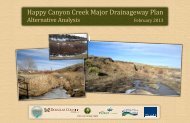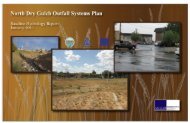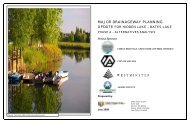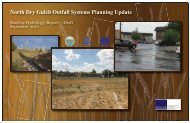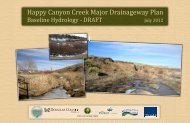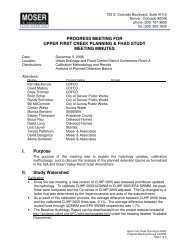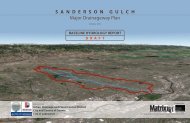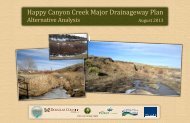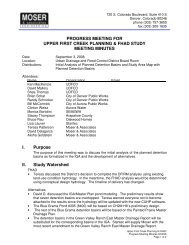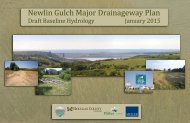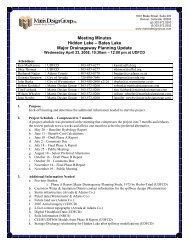Final Baseline Hydrology Report - October 2012 - Urban Drainage ...
Final Baseline Hydrology Report - October 2012 - Urban Drainage ...
Final Baseline Hydrology Report - October 2012 - Urban Drainage ...
You also want an ePaper? Increase the reach of your titles
YUMPU automatically turns print PDFs into web optimized ePapers that Google loves.
Sanderson Gulch Major <strong>Drainage</strong>way Plan<br />
<strong>Baseline</strong> <strong>Hydrology</strong> <strong>Report</strong> <strong>October</strong> <strong>2012</strong><br />
3.0 HYDROLOGIC ANALYSES<br />
3.1 Overview and Methodology<br />
This study updates the major drainageway design flood flows based upon current criteria for the entirety of<br />
the Sanderson Gulch watershed including the tributary North Sanderson Gulch.<br />
The approach to development of the updated hydrologic modeling for the watershed was established in the<br />
kickoff meeting. The hydrology should not be changed simply due to the use of different hydrologic models.<br />
Therefore, it was important to re-create the 1972 model for Sanderson Gulch and Weir Gulch. The<br />
Sanderson Gulch portion of the 1972 MDP was extracted as it is hydrologically not connected to Weir Gulch<br />
and for the initial calibration exercise excluded the Mississippi Gulch watershed since no flows came to<br />
Sanderson Gulch from that watershed until the completion of a minor storm transbasin outfall in 1981. This<br />
re-created model, termed the “Duplicate Hydrologic Model,” was then edited using corrected rainfall and<br />
impervious values, and was termed the “Corrected Hydrologic Model.” The following two-step process was<br />
followed:<br />
1) Duplicate Hydrologic Model – Since an electronic file was not available for the 1972 model, the previous<br />
model was re-created. The watershed and sub-basins were delineated similar to the 1972 study;<br />
however the sub-basins were further subdivided to be less than 130 acres to meet current UDFCD<br />
criteria. Basin hydrologic parameters and rainfall from the 1972 MDP were adopted. This information<br />
was entered into the most current versions of UDFCD’s hydrologic models, and the results calibrated to<br />
match, as closely as possible, the 1972 MDP discharges at selected design points.<br />
2) Corrected (<strong>Baseline</strong>) Hydrologic Model – Starting with the Duplicate Hydrologic Model, stage-storagedischarge<br />
curves for each detention pond in the 1972 model for Sanderson Gulch were revised and<br />
updated as necessary to match current conditions. Current basin imperviousness was applied to each<br />
subbasin. The design rainfall values were updated to match current values according to the UDFCD<br />
criteria manual.<br />
For both the Duplicate and Corrected (<strong>Baseline</strong>) Hydrologic Models, the Colorado <strong>Urban</strong> Hydrograph<br />
Procedure (CUHP 2005), version 1.3.3 was used to generate hydrographs for each subwatershed for the 2-,<br />
5-, 10-, 25-, 50-, and 100-year storm return periods. Hydrographs for the subbasins were routed using the<br />
Environmental Protection Agency Stormwater Management Model (EPA SWMM), version 5.0.022, to<br />
determine peak discharge rates at design points.<br />
Model development and results for each of the two major modeling steps is described in the following<br />
sections.<br />
3.2 Duplicate Hydrologic Model<br />
In order to create a Duplicate Hydrologic Model, the 1972 MDP basin delineation was revised to meet<br />
current UDFCD criteria while attempting to leave basin parameters unchanged. Subbasin delineation,<br />
changes to infiltration and pond routing and subsequent calibration of the model results to arrive at the<br />
Duplicate Hydrologic Model are described in the following sections.<br />
3.2.1 Subwatershed Delineation<br />
The 1972 MDP divided the Sanderson Gulch watershed into 20 subbasins. These original 20 subbasins<br />
were subdivided into a total of 89 new subbasins to comply with current UDFCD modeling criteria.<br />
Subdividing of the original basins was based on topographic mapping, road profiles, curb and gutter,<br />
cross pans, previous drainage studies and site observations. Mapping used for the delineation consisted<br />
of 2-foot contour interval topography based on a 2008 LIDAR survey provided by Denver, one-foot<br />
contour interval mapping flown by Accurate EngiSurv in June, <strong>2012</strong>, and 10-foot contour interval USGS<br />
mapping.<br />
In accordance with UDFCD guidelines, subbasins within the study area were delineated so that no single<br />
subbasin exceeded 130-acres in area, and individual subbasins averaged no more than 100 acres.<br />
Subbasin delineation parameters are summarized in the Table 3-1. The maximum subbasin area is 150<br />
acres because Ward Reservoir Number 5 could not be further sub-divided. The second largest subbasin<br />
area is 122 acres.<br />
In addition to the Sanderson Gulch watershed, two-off site basins contribute runoff through storm<br />
drainage systems. The off-site basins are the Mississippi Gulch basin and Federal Boulevard / Lowell<br />
Avenue basin. These two off-site basins are not included in the Duplicate Hydrologic Model because they<br />
were not part of the 1972 MDP. They are included in Table 3-1 because they are used later in the<br />
Corrected Hydrologic Model.<br />
Table 3-1 Subbasin Delineation Summary<br />
Total Area<br />
Average<br />
Sub-basin<br />
Area<br />
Minimum<br />
Sub-basin<br />
Area<br />
Maximum<br />
Sub-basin<br />
Area<br />
(sq. mi.) (acres) (acres) (acres)<br />
Total No.<br />
of Sub-<br />
Basins<br />
Study Area<br />
(Sanderson Gulch Watershed)*<br />
Offsite Area<br />
(Federal Blvd and Lowell Ave)<br />
Offsite Area<br />
(Mississippi Gulch)<br />
7.6<br />
0.48<br />
0.92<br />
54.6<br />
61.4<br />
84<br />
1.16<br />
38.1<br />
37.4<br />
150<br />
93.1<br />
122.7<br />
89<br />
5<br />
7<br />
* Duplicate Hydrologic Model does not include the off-site Mississippi Gulch and Federal Boulevard / Lowell<br />
Avenue basins.<br />
Subbasin flow paths and slopes were determined using the project topography previously described. For<br />
the subbasins with drainageway slopes greater than 0.04 ft/ft, Figure RO-10, Slope Correction for Natural<br />
and Grass-Lined Channels in the UDFCD <strong>Urban</strong> Storm <strong>Drainage</strong> Criteria Manual (USDCM) was used for<br />
the adjustment. Figure B-1 in Appendix B shows the delineation of subbasins. The recommended<br />
watershed shape factor, which is the drainage basin length-to-width ratio, should not exceed 4 to 1 per<br />
UDFCD guidance. All subbasins were delineated for compliance with the shape factor criteria which<br />
unavoidably produced some small subbasins.<br />
27



